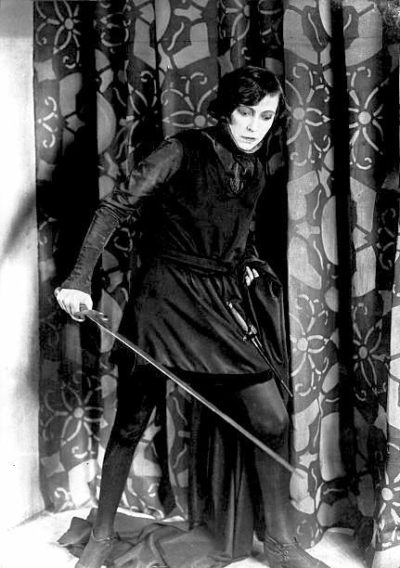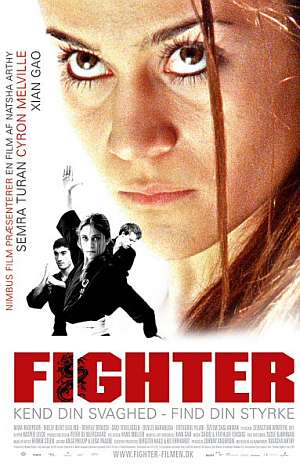★★★
“To she, or not to she…”
 Asta Nielsen was not the first woman to play the part of Hamlet, even on film. As we’ve mentioned before, a short reel of Sarah Bernhardt performing the role was made as early as 1900. But this silent Danish movie, celebrating its centenary at the time of posting, is the first full-length feature to gender switch the role. It was inspired by Edward P. Vining’s book The Mystery of Hamlet, published in 1881, which suggested that the character made a lot more sense if you considered Hamlet to be a woman. An interesting idea, to be sure, and obviously changes significantly the relationship between Hamlet and both best friend Horatio, and Ophelia.
Asta Nielsen was not the first woman to play the part of Hamlet, even on film. As we’ve mentioned before, a short reel of Sarah Bernhardt performing the role was made as early as 1900. But this silent Danish movie, celebrating its centenary at the time of posting, is the first full-length feature to gender switch the role. It was inspired by Edward P. Vining’s book The Mystery of Hamlet, published in 1881, which suggested that the character made a lot more sense if you considered Hamlet to be a woman. An interesting idea, to be sure, and obviously changes significantly the relationship between Hamlet and both best friend Horatio, and Ophelia.
Of necessity, there are therefore some changes to the story. It begins with a prelude in which Hamlet’s father is away at war when his wife Gertrude gives birth. Fearing for her husband’s life, and wanting to secure the throne’s succession, she announces the girl child as a boy [a similar plotline was used in the Indian fllm, Rudhramadevi]. On her husband’s return, they vow to keep up the pretense. We also see more of Hamlet’s youth, attending the University of Wittenberg and forming her relationship with Horatio (Stieda), before being called back to Denmark. That happens when the king is murdered by her uncle, Claudius (von Winterstein), who has quickly married her mother, Queen Gertrude (Brandt). The supernatural element of the ghost of Hamlet’s father is also removed, in favour of Hamlet discovering Claudius’s knife in suspicious circumstances.
Thereafter, however, it follows familiar lines, with Hamlet faking madness in order to be able to investigate freely, and not be considered a threat. It’s probably this version’s weakest section, since it doesn’t seem she does much actual investigating, and watching someone pretend to be insane is kinda dull, especially in a silent version, with the inevitable tendency towards the over- side of acting. There’s also an absence of the Bard’s classic dialogue, for obvious reasons: no “To be, or not to be” in this version. When Hamlet stages a play re-enacting the death of her father, things perk up and head towards the rousing if tragic finale [spoiler: just about everyone dies].
This is not quite the oldest film reviewed here, Joan the Woman preceding its 1921 release by five years. Hamlet isn’t as successful, replacing the rousing battle scenes of Joan with some fairly stagey sequences of emoting by Nielsen, which at times did struggle to hold my interest. That said, Nielsen is actually very good in the role, and some scenes have power, such as her intense slithering across the floor to watch Claudius’s reaction to the play. I’ve queued up some of her other performances for later perusal. There’s something endearingly Goth about the production here, with her Hamlet being all dressed in black, with floppy hair and eye make-up. At times it almost looks like a promo video for The Cure. But other elements, such as Ophelia’s funeral, are highly Expressionist, with the film using bold tints to indicate location.
If what has been written above has piqued your interest, the whole thing is available on YouTube. While probably not something I’ll re-visit, I can’t say I felt like my two hours were wasted. It’s certainly an interesting take on a character which continues to fascinate and provoke debate, over 400 years after the play was first published.
Dir: Svend Gade and Heinz Schall.
Star: Asta Nielsen, Eduard von Winterstein, Mathilde Brandt, Heinz Stieda






 To the makers’ credit, they are perfectly up-front about this being made for pennies, with home video equipment and edited on a laptop. But even though I’m not averse to that – heck, I’ve been involved with films on such microbudgets myself – there’s still too much here that’s avoidably bad. For instance, if you are going to put the President of the United States in your film, be sure you have access to someone with a grasp of English that extends past “D+, must try harder”. If you don’t, then leave them out.
To the makers’ credit, they are perfectly up-front about this being made for pennies, with home video equipment and edited on a laptop. But even though I’m not averse to that – heck, I’ve been involved with films on such microbudgets myself – there’s still too much here that’s avoidably bad. For instance, if you are going to put the President of the United States in your film, be sure you have access to someone with a grasp of English that extends past “D+, must try harder”. If you don’t, then leave them out. Certainly one of a kind, this coming-of-age film tells the story of Aicha (Turan), a Muslim girl born of Turkish parents, who is obsessed with learning martial arts – the last thing her father wants. This thoroughly unfeminine interest, in the eyes of her community, is carried out in secret, but Omar (Banissi), a friend of her brother’s fiancee’s family finds out, and is thoroughly unimpressed. “I don’t fight girls,” he says dismissively, when ordered to spar with Aicha, and this leads to his ejection from the club by their teacher (Xian). When he confronts Aicha at the engagement party, the resulting argument becomes a brawl, and leads to the breaking off of the engagement – which is doubly unfortunate, as the bride-to-be is discovered to be pregnant. Meanwhile, Aicha has to prepare for an upcoming tournament, alongside her training partner, Emil (Melville) – and for which Omar has also signed up as a contestant.
Certainly one of a kind, this coming-of-age film tells the story of Aicha (Turan), a Muslim girl born of Turkish parents, who is obsessed with learning martial arts – the last thing her father wants. This thoroughly unfeminine interest, in the eyes of her community, is carried out in secret, but Omar (Banissi), a friend of her brother’s fiancee’s family finds out, and is thoroughly unimpressed. “I don’t fight girls,” he says dismissively, when ordered to spar with Aicha, and this leads to his ejection from the club by their teacher (Xian). When he confronts Aicha at the engagement party, the resulting argument becomes a brawl, and leads to the breaking off of the engagement – which is doubly unfortunate, as the bride-to-be is discovered to be pregnant. Meanwhile, Aicha has to prepare for an upcoming tournament, alongside her training partner, Emil (Melville) – and for which Omar has also signed up as a contestant. Not to be confused with the (rather tedious, IMHO) bunch of New York feminist artists, this is about Isabel, the well-educated daughter of a middle-class family, who opts to toss it all away and go into the jungles of Colombia to fight the revolution with FARC, the insurgents who have been rebelling against the government for more than 40 years. She undergoes training, both political and military, and has to adapt to an environment radically different from the one she knew before. It’s not always successful, and you wonder how she’s ever going to become a “freedom fighter” when she can’t even take part in the slaughter of a cow. [shown, below right – PETA activists will
Not to be confused with the (rather tedious, IMHO) bunch of New York feminist artists, this is about Isabel, the well-educated daughter of a middle-class family, who opts to toss it all away and go into the jungles of Colombia to fight the revolution with FARC, the insurgents who have been rebelling against the government for more than 40 years. She undergoes training, both political and military, and has to adapt to an environment radically different from the one she knew before. It’s not always successful, and you wonder how she’s ever going to become a “freedom fighter” when she can’t even take part in the slaughter of a cow. [shown, below right – PETA activists will  e the film-makers didn’t want to go down that avenue, and since they were out in the jungle, with a group of heavily-armed insurgents, I can hardly blame them for letting that angle slide. Instead, it lets the film speak for itself, and FARC does sometimes come across as little better than kids playing soldiers: one, particularly memorable part of the training, consists of recruits running around, waving wooden guns about and shouting “BANG!” at imaginary opponents. They also have a startlingly bad ‘national anthem’, which sounds more like the fight song from a third-rate community college.
e the film-makers didn’t want to go down that avenue, and since they were out in the jungle, with a group of heavily-armed insurgents, I can hardly blame them for letting that angle slide. Instead, it lets the film speak for itself, and FARC does sometimes come across as little better than kids playing soldiers: one, particularly memorable part of the training, consists of recruits running around, waving wooden guns about and shouting “BANG!” at imaginary opponents. They also have a startlingly bad ‘national anthem’, which sounds more like the fight song from a third-rate community college.